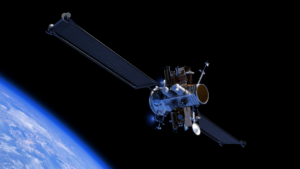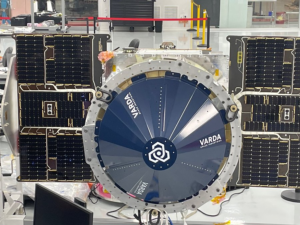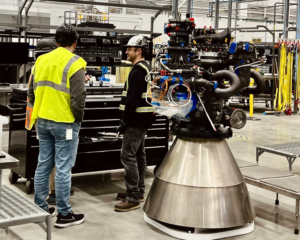
Blue Origin Is Preparing To Launch New Glenn!
Blue Origin is a company that usually keeps most of its progress and developments to itself. This left the majority of people under the impression that New Glenn, the company’s next-generation launch vehicle, was still many years away from an actual flight test. Earlier today, however, the company shared some significant new information.
This included an image of both a test ready first and upper stage of New Glenn being mated in the company’s hanger. This marks the first time the company has done this and is a major step in the goal of launching the rocket later this year. Here I will go more in-depth into the new update from Blue Origin, what we know about the flight later this year, upcoming tests, and more.
A Full New Glenn

Just hours ago, Blue Origin tweeted saying, “The first and second stages of New Glenn’s test vehicle mate for the first time, enabling us to exercise our tooling and stage interfaces in preparation for our first launch later this year.” This included an image of the two stages coming together inside the company’s facility at Cape Canaveral. The reason this is such a big deal has to do with the stages coming together. These are not structural test articles with hollow insides. Instead, these are fully capable and practically complete New Glenn components.
Over the last few weeks, the company released images of the first stage and even the upper stage. The first stage could be seen with proper mounting hardware, a full paint job, aft section, etc. At the time only the interstage, which sits in between the first and second stage, was reported to be simply structural, and not meant for flight. As for the upper stage, last week we got a great image thanks to Blue Origin’s CEO. In the image, it becomes obvious that these stages are very capable of actual operations. Here you can see the two BE-3U engines which each generate around 160,000 lbf (710 kN) of thrust in vacuum.
In a LinkedIn post, CEO David Limp was quoted saying, “While there’s still a lot of work ahead, we’ve recently hit a couple of exciting and visible milestones for our forthcoming New Glenn rocket – and customers entrusting us with their payloads. Our first and second stage hardware have both left the factory and are now at our Launch Complex 36 in Cape Canaveral. That 8-mile drive yesterday was fun to watch, but I am sure stressful for the truck driver and crew” he said. This was specifically referring to the recent rollout. Since then both stages were returned to the facility and now are being mated together.
In today’s tweet, they mention that this process will allow them to exercise there tooling and stage interfaces. In reality, this is likely the first time they have done this process with capable hardware meaning some of the operations will be new in a way. Assuming the process goes smoothly which is expected, they will have a great baseline and valuable experience to apply before an actual flight attempt.
As far as whether or not the stages we are seeing right now will fly is not completely clear. As partially mentioned prior, various not meant for flight markings have been spotted. This being said, the stages are clearly not very far from capable, meaning Blue Origin could refit them for flight. There is also some obvious missing hardware including strakes, fins, and landing legs. However, all of those additions are not necessary for ground testing and could be added later for flight.
With all this in mind, the tweet also did confirm that they are still planning to launch later this year. In the coming weeks, we can hope to receive more updates from the company and insight on their exact plans for the rest of this year.
Launch Date

With Blue Origin still working toward a launch in 2024, the question becomes what will this launch look like and when will it be. Thankfully, because of a partnership with NASA, we actually have some decent insight into this mission. Last year NASA awarded Blue Origin a task order to provide launch service for the agency’s Escape and Plasma Acceleration and Dynamics Explorers (ESCAPADE) mission, as part of the agency’s Venture-Class Acquisition of Dedicated and Rideshare (VADR) launch services contract. In the statement, the agency is quoted saying, “ESCAPADE will launch on Blue Origin’s New Glenn rocket from Space Launch Complex-36 at Cape Canaveral Space Force Station in Florida. Launch is targeted for late 2024.”
Unlike a lot of other maiden flights, ESCAPADE is a twin-spacecraft Class D mission that will study solar wind energy transfer through Mars’ unique hybrid magnetosphere. Adding to the theory that this mission will be New Glenn’s first, recently, at a November 20 meeting of the NASA Advisory Council’s human exploration and operations committee, Bradley Smith, director of NASA’s Launch Services Program, said the agency’s Mars-bound ESCAPADE smallsats will fly on an “incredibly ambitious first launch for (Blue Origin’s) New Glenn” rocket “around this time next year.” He continued by saying, “We will very likely be the very first launch of New Glenn.”
To build on this, when talking about the mission risk, Smith said, this is acceptable, since ESCAPADE is what NASA characterizes as a “class D” mission with a higher tolerance for risk. “We’re willing to take a little bit of risk with a price tag and a mission assurance model that reflects that risk” he said.
These are bold comments as he suggests that even with less than a year until this mission is expected to lift off, he believes Blue Origin will be ready. In another quote, he said, “There’s certainly some schedule risk associated with New Glenn getting to the pad,” noting he has seen Blue Origin’s schedule for the vehicle but did not disclose details about it. It’s also important to point out that because this is a Mars mission, there are extremely limited options as far as launch delays go. Mars gets in position every two years for a mission and there is only a small time period where you can launch and begin the journey to eventually meet the red planet. Just a few months of delays could cancel the mission or force the agency to change vehicles.
In terms of a specific date, August has been mentioned for ESCAPADE. However, there obviously are a lot of unknowns, and expecting at least some delays is realistic. Even still, a few months would push it back to around December of this year.
For a while now the sentiment has been that Blue Origin could realistically get New Glenn in the air sometime in 2025. That would be initial test flights and would also give time for any errors or problems along the way. You have to consider the New Glenn by itself is a very ambitious vehicle and will include a lot of firsts for the company. Landing the booster out at sea for example will likely take a few attempts before they get it right.
Another big question related to this launch and especially future missions with New Glenn is the BE-4 engine and its production. Despite all the new pictures of the real booster, a cover on the Aft module keeps its internals hidden. This means we aren’t sure if 7 BE-4 engines are installed or not. On the bright side, the recent Vulcan launch was a success and the first flight of the BE-4. This will provide Blue Origin with some invaluable information on how exactly they perform during a mission.
Focusing on production, New Glenn needing 7 per booster and ULA starting to launch Vulcan means the engine’s demand will significantly increase starting right about now. To be specific, based on comments from ULA CEO Tory Bruno, the company can expect to require 48 engines a year equating to two Vulcan launches a month.
These numbers are somewhat intimidating but Blue Origin is aware of the demand. In recent months, the company has been ramping up this next-generation engine’s production by quite a bit. In October of last year, we first got a hint at this when the company said in a report that “Dozens of these engines are now in production to support a large and growing demand for civil, commercial, and defense launches.” More recently, they released footage inside the regen nozzle room in the Huntsville engines factory. Here dozens of BE-4 engines can be seen in early production. All of this in preparation for an increase in expected demand.
The BE-4 is immensely important for New Glenn’s future. They highlight that BE-4 was designed from the beginning to be a medium-performing version of a high-performance architecture. A conscious design choice made to lower development risk while attempting to meet performance, schedule and reusability requirements. For propellant, they chose LNG because it is highly efficient, low cost and widely available. Unlike kerosene, LNG can be used to self-pressurize its tank. Known as autogenous repressurization, this eliminates the need for costly and complex systems that draw on Earth’s scarce helium reserves. LNG also possesses clean combustion characteristics even at low throttle, simplifying engine reuse compared to kerosene fuels. An important benefit considering New Glenn’s reuse plans.
Over the next few weeks, we can expect to see even more of the test articles and receive insight from Blue Origin. In order to complete a flight later this year, key testing will need to start soon.
Conclusion
Blue Origin just shared an update on New Glenn as they begin to mate a first and second stage test article. This is a big deal and an important step for the company in preparation for a maiden flight. We will have to wait and see how it progresses and the impact it has on the space industry.



